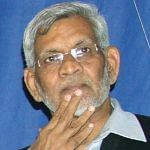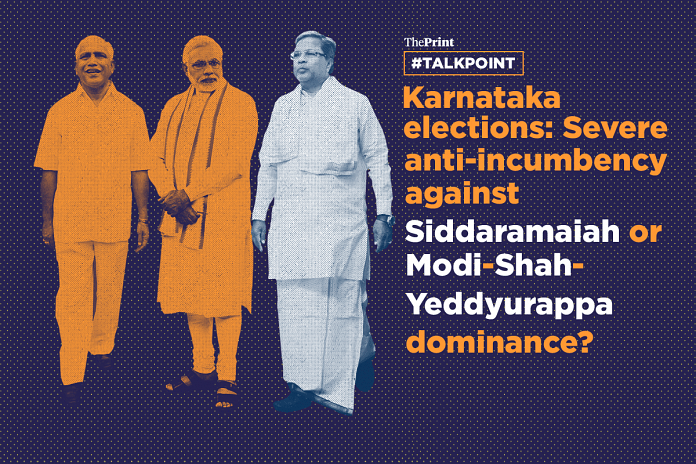As the votes are counted in Karnataka, trends indicate that the BJP will emerge as the single largest party. The Congress’ performance under chief minister Siddaramaiah has turned out to be way worse than was predicted in the exit polls.
ThePrint asks: Karnataka elections: Severe anti-incumbency against Siddaramaiah or Modi-Shah-Yeddyurappa dominance?
What Karnataka decides isn’t always what the rest of India decides
 Brijesh Kalappa
Brijesh Kalappa
Spokesperson, Congress
What we are seeing in Karnataka isn’t what I would call Yeddyurappa’s dominance.
We have to take note of the fact that Karnataka has not returned a government to power in over 30 years. The last consecutive term for a party happened in 1985. So, the results seem to be in keeping with the larger trend.
Also, it is not like the Congress has been wiped out. We are leading in 75 seats. That’s a good number for a strong opposition. We have and will continue to stand our ground.
It was indeed a hard-fought election. Of course, we would have been happier if we had done better. However, once the final results are declared, we will regroup and analyse what we lacked.
Even so, it’s important to note that what Karnataka decides isn’t always what the rest of India decides. Karnataka has always voted for a government where the Centre and state don’t align. It happened as recently as 2013, when they voted for Siddaramaiah and the BJP came to power in 2014. It seems like the vote share they gathered in 2014 hasn’t eroded much.
Even if we do not win, we will gracefully accept defeat and continue working for the people of Karnataka.
The well-oiled election machinery of the Modi-Shah duo worked wonders
 Tanveer Ahmed
Tanveer Ahmed
National Spokesperson, JD(S)
The Congress concentrated on all the wrong issues, like those of removing Hindi from the state and recommending separate religion status for Lingayats — these don’t really matter to people on a day-to-day basis. It is policies and how you deliver them that makes a difference. The Congress under Siddaramaiah got lost in its own rhetoric.
Also, the well-oiled election machinery of the Modi-Shah duo worked wonders on the ground. The plethora of union ministers, chief ministers, and Sangh Parivar members who descended on Karnataka clearly played a crucial role in swinging the vote. The pomp and show of Modi’s rallies, the money, and, not to forget, the couple of media channels surreptitiously promoting the BJP, gave the party the upper hand.
Yeddyurappa isn’t the leader the people of Karnataka wanted to follow; he is a CM candidate without leadership qualities. Under Modi’s umbrella are also criminals like the Reddy brothers and people who have been caught watching inappropriate videos in the assembly.
This is not a mandate for the BJP; it is a vote against Siddaramaiah. It is a vote against Rahul Gandhi, whose comments against Deve Gowda backfired.
After the last assembly elections, the BJP took four of our MLAs and the Congress took 10. We were reduced to 26. Despite that, we have done well. We will not lose heart and will continue to work for the people of Karnataka.
But we must remember, this will not set the stage for 2019. Modi may be flying high right now but the people will be asking him tougher questions in 2019. Pro-farmer, secular parties will come together against the BJP. The Congress, however, has to listen to regional forces. It doesn’t have the leadership to command or rule India.
This result shows Amit Shah and Narendra Modi have their ears to the ground
 Malavika Avinash
Malavika Avinash
BJP spokesperson
The people of Karnataka have chosen a representative who they know will work for them. The BJP’s agenda has always been the development of Karnataka.
When we were campaigning, we could feel that there was an immense anti-incumbency sentiment against the Congress, especially Siddaramaiah, on the ground. Be it corruption in his government, the agrarian crises, or lawlessness, people were very unhappy with Siddaramaiah’s performance in general. We have swept coastal Karnataka precisely because of the lawlessness in the region. The death of many Hindu workers in the region has come back to haunt the Congress.
This is another victory for team Amit Shah. It shows that both Shah and Narendra Modi have their ears to the ground. They know how to conduct an election. Modi has led a very clean campaign as opposed to the divisive politics of the Congress. The Congress played on the north-south divide, flag polarisation, Lingayat consolidation, but none of that worked. People instead focused on Narendra Modi’s promise of development for everyone.
Karnataka didn’t develop alongside the rest of India under Modi’s stewardship because of the lackadaisical attitude of Siddaramaiah. The people have voted for change, for Amit Shah, and for the BJP. This is a clear mandate for the party.
It is heartening to see that people of Karnataka will have a BJP government in the state as well as at the Centre. This is a precursor to the NDA’s victory in 2019. Narendra Modi will soon return as Prime Minister.
No visible anti-incumbency against Siddaramaiah, but possible anti-incumbency towards specific MLAs
 Mathew Idiculla
Mathew Idiculla
Research Consultant, Centre for Law and Policy Research, Bengaluru
Karnataka, like its southern counterparts Tamil Nadu and Kerala, is one of the states that have consistently shown an anti-incumbency trend in assembly elections for over three decades.
While Jayalalithaa was able to counter this trend for the AIADMK in the 2016 Tamil Nadu election, Siddaramaiah has not been able to do the same for the Congress in Karnataka. This might initially suggest that Karnataka is merely sticking to its usual electoral pattern, but the story emerging appears more complicated.
Most ground reports from Karnataka suggested that there was no major statewide dissatisfaction with the performance of the Siddaramaiah government. In fact, the numerous ‘bhagya’ welfare schemes of the government have benefited the majority of the population and are seen positively by the people. Hence, it would not be accurate to say that there was severe anti-incumbency against Siddaramaiah.
However, anti-incumbency operates at two levels: The level of the government and the level of the MLA.
While there was no visible anti-incumbency against the Siddaramaiah government, it is possible that there was anti-incumbency towards specific MLAs. In case of anti-incumbency against MLAs, it was the Congress that stood to lose the most since it fielded the highest number of incumbent MLAs.
Narendra Modi’s blitzkrieg in the final phase of the election seems to have been decisive in the BJP’s surge. Before Modi’s arrival, the BJP’s campaign was going awry. While Amit Shah played a key role organisationally, Yeddyurappa’s contribution was in keeping the BJP together. Along with the Modi effect, what might have gone against the Congress is the consolidation of dominant castes against Siddaramaiah as his government’s welfare measures were perceived to be skewed in favour of the backward communities.
Instead of acting as a kingmaker, JD(S) has acted as a spoiler for Congress
 Harish Ramaswamy
Harish Ramaswamy
Professor, political science, Karnataka University, Dharwad
This is a positive vote for Narendra Modi. B.S. Yeddyurappa is only one of Modi’s instruments in Karnataka.
Anti-incumbency can be determined only once the elections are over. The expression I would rather use is ‘positive vote’ — People have positively voted for Modi to defeat Siddaramaiah.
People clearly took a liking to Modi. After he joined the campaign, there was a whirlwind of change. Suddenly, the whole cadre was enthused and the people followed.
Five of the exit polls had said the BJP would gain a simple majority. Amit Shah was very confident from the beginning.
There are three main factors for Congress’ loss. Firstly, they were over-confident. Siddaramaiah’s leadership gave the BJP a tough fight, but he was always considered arrogant. Secondly, he tried to stretch the criminal corruption angle in reference to Yeddyurappa and the Reddy brothers. People didn’t take kindly to that. Lastly, his cajoling of the Kuruba community didn’t work for the Congress.
Instead of acting as a kingmaker, the JD(S) has acted as a spoiler for the Congress, taking away most of their votes. If there had been an understanding between H.D. Deve Gowda and the Congress, things could have been different.
The verdict clearly shows that the minority status for the Lingayats didn’t work for Congress
 Muzaffar Assadi
Muzaffar Assadi
Political analyst, Karnataka
One thing can be clearly observed, there was neither an anti-incumbency, nor a pro-incumbency sentiment at play. The result is probably the result of two dominant castes, the Vokkaligas and the Lingayats, coming together against the Congress.
North Karnataka, where the BJP has made inroads, is a Lingayat-dominated area. The Lingayat consolidation in favour of the BJP clearly shows that providing minority status to the Lingayats didn’t work for the Congress.
In Old Mysuru, the JD(S) has secured the maximum seats. It shows that even the Vokkaligas did not want the Congress to return to power. Both the castes perceive Siddaramaiah as someone who doesn’t favour them. They want to return to power, and the only way they believe they can do that is by getting Siddaramaiah out of the picture.
In the coastal belt, the BJP has obviously recovered. It is here that Modi’s charisma and Shah’s campaigning have played a dominant role. It is precisely because of this region that the BJP may reach a simple majority.
BJP will have to think about party organisation as much as about government formation
 Narayana A.
Narayana A.
Political analyst and professor of political philosophy at Azim Premji University
This time, Modi did everything he could. There also was an efficient party machinery that worked from both above and below. Although it was not visible very much, there was also a slight anti-incumbency in their favour.
In 2008, the BJP rode a formidable sympathy wave and hit 110. This time, there was no such factor. The only positive parameter was a very powerful Prime Minister. Modi’s image was probably what pushed them to secure 104 seats. In my opinion, this is the maximum the BJP can aspire to in Karnataka. The sympathy wave from the last time was a rare and powerful occurrence, and that itself secured only limited numbers in the BJP’s favour. They couldn’t hit even 113.
Even this 104 has come because they realigned and regrouped with the Reddys of Ballari. This determined the outcome in at least five to seven seats. Government formation is one thing, but the BJP will have to think about party organisation as much as it does about government formation.
Congress definitely did not fail badly in the north, about 35 per cent of Lingayats voted for Congress.
 S. M. Jamdar
S. M. Jamdar
Retired IAS officer, Lingayat leader
This was expected and predictions were also on the same lines. The way the BJP fielded tainted candidates and the way they were canvassing, it was obvious that BJP will take some chunk of the votes. At the same time, Congress isn’t to blame any less.
The first three years of Siddharamaiah governance was highly criticised. In the last 1.5 years, he tried to revive his reputation to little success. His objective of pandering to Muslim votes and celebrations of Tipu Jayanti had antagonised a large Hindu votebank. As a result, the Muslims were divided between the JDS and Congress, as evidenced in the Mandya and Kolar districts. So this is the kind of backlash that boomeranged against him.
BJP has cut a sorry figure too. Not even a single seat came to BJP in Mandya and Kolar. In Gowda areas too, it wasn’t good. Despite Modi and several senior leaders campaigning, BJP’s performance has not been upto the mark.
Congress definitely did not fail badly in the north. I would say approximately 35 to 40% of Lingayats voted for Congress. But Congress failed miserably in the south where it was strong earlier. Mysore, Chamrajnagar, Ramnagara, Chikbalapur were terrible. Furthermore, they did not campaign well. They weren’t truly fighting as a united party, only on candidate basis.
As a result of this, the hung assembly was nothing unexpected.
Compiled by Deeksha Bhardwaj, journalist at ThePrint.



